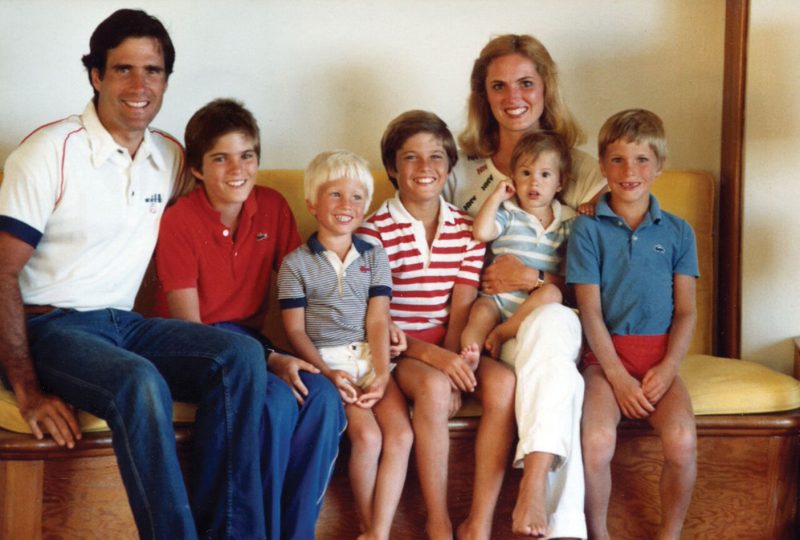The Disruptor
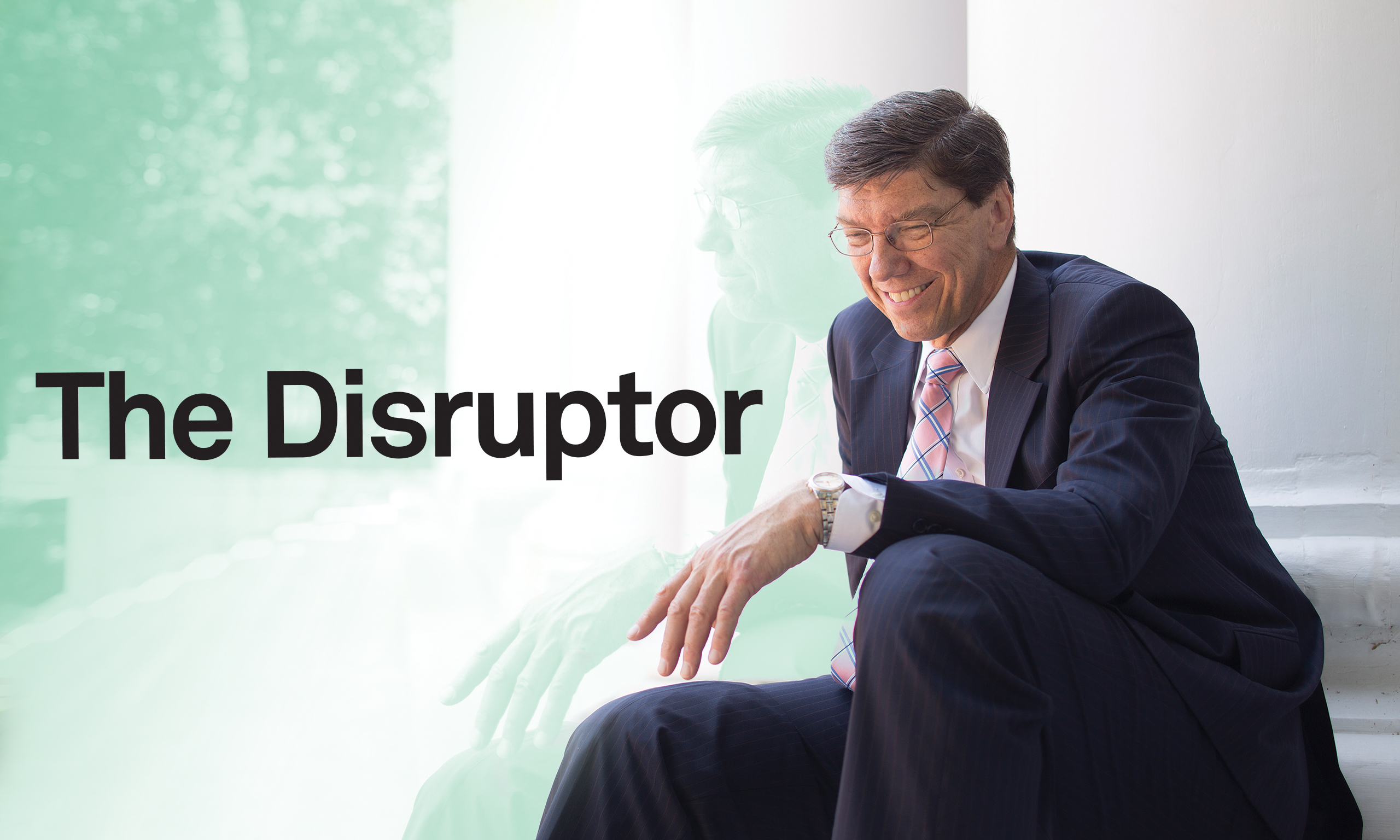
How a down-to-earth alum upended the business world and built a career—and a life—that is getting everyone’s attention.
By Peter B. Gardner (BA ’98, MA ’04) in the Spring 2013 Issue
On a July 2010 Sunday morning Clayton M. Christensen (BA ’75) towered above a 6:30 a.m. gathering of bishoprics in the Cambridge, Mass., stake center. With one hand in his suit pocket, the other gesturing confidently, the high council representative applied the tools of his craft—stories and studies, trends and testimony—to a favorite subject: member missionary work. A Harvard professor, world-renowned business thinker, best-selling author, keynote speaker, and dauntless sharer of the gospel, Christensen had spent a life refining the art of words for moments just like this.
Christensen’s oldest son, Matthew, was in attendance that morning, following the familiar stories and themes flowing through his father’s words when, suddenly, “he just stopped making sense,” Matthew remembers. Midsentence, his father had crossed some invisible boundary. “Sounds would come out, occasionally words,” Matthew says, “but none of it made any sense.”
Seconds later, the two nearly 7-foot-tall men stood face-to-face. Could this be a stroke? Matthew wondered. His dad’s face looked symmetrical. When they grasped arms to shuffle Clayton through the crowded room to an open seat, Matthew noticed that both of his dad’s arms felt equally strong. Over two years his 58-year-old father had fought through a string of maladies—a heart attack, lymphoma, a detached retina. But now Matthew suspected his dad—30 years a type-1 diabetic—might be experiencing a sugar low.
When an oral infusion of Skittles and Snickers from Clayton’s briefcase made no difference, they decided to check his blood sugar—which read high, not low. A neurological radiologist in attendance then administered a quick neurological exam, and Clayton failed miserably. Sensing this was an emergency, they rushed him to Massachusetts General Hospital, just across the Charles River.
At the hospital they soon learned that a blood clot had lodged in a vessel in Christensen’s brain above his left ear—the area where speech is formulated. Doctors administered a clot-busting drug, and thanks to the quick response, Christensen’s life had once again been spared.
His speech, however, had not.
“Instead of giving them grades, I should have bought stock.” —Larry Wimmer
At the height of his career as a professor and writer, Christensen suddenly could neither speak nor write—all his insights corralled within, rearing and stamping. His heart attack and cancer had been equally perilous, but the stroke cut straight to the core of what it meant to be Clayton Christensen.
In a Forbes magazine article, Christensen would later explain that it was as though the mental filing cabinet where words are stored had been tipped over, throwing everything out of place. And now it was up to him to painstakingly sort through the mess and refile everything in his brain’s right hemisphere. Along with therapy sessions, Christensen began making vocabulary lists and picked up software for learning English, which he used to challenge his 6-year-old granddaughter Madeline to noun-naming competitions. “She just beat the pants off me,” he admits.
Progress was maddeningly slow, and with the passing months Christensen found himself overtaken by a cloud of depression—something he had never experienced. “I just wanted to go down to the basement and make furniture, because then I [wouldn’t] have to talk to people,” he says. “The more I focused on myself, the unhappier I became.”
A break in the clouds came, he says, once “I screwed my head on straight.” It came when he recalled a statement of purpose he had sketched out years before, one founded in a focus on others, not himself. Light returned when he remembered that God would measure his life not by fluency, but by how he helped others.
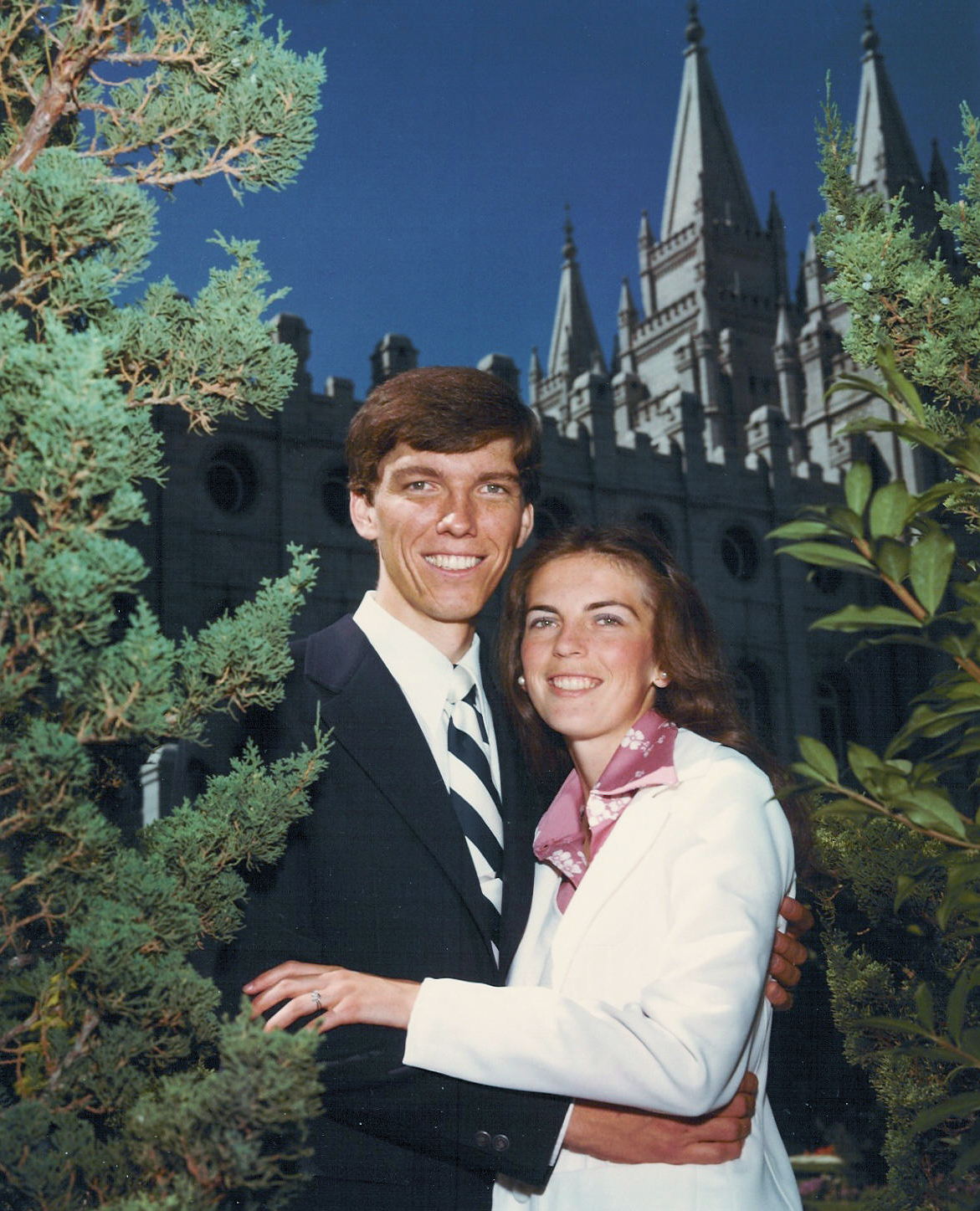
Ordinary Clay
Clayton Christensen is a walking oxymoron. Voted in 2011 by the business community as the world’s most influential management thinker, he is as looked up to professionally as he is physically. And yet there’s nothing lofty, condescending, or intimidating about Christensen—whom everybody, from colleagues to young adults in the Cambridge wards, seems to know as just Clay. His professorial arched eyebrows are tempered by smile-crinkled eyes, and his voice, a sort of Kermit the Frog pitched an octave lower, is all warmth and aw-shucks friendliness that quickly levels him with audiences of hundreds or just one.
The apparent contradictions developed early as Christensen grew up in Salt Lake’s modest Rose Park neighborhood, full of ’50s-era red-brick starter homes and large families. He and his seven equally lanky siblings were children of the stake president, the produce manager downtown at ZCMI. Friend and neighbor Keith Stepan says Clayton’s father, Robert Christensen, was known for having “the biggest heart and softest hands” and for the stories of pioneer fortitude and courage he wove into his sermons. Clayton’s mother, Verda Mae Christensen—in whose name the Christensens established an endowment in support of BYU’s theatre program—had worked for a time at KSL and later served for 11 years on the Young Women General Board. She instilled in her children an ambition for learning. “The more you learn, the more talents that you develop, the more ways God can shape you to be useful in the kingdom,” she’d tell them.
Clayton, who had read the entire World Book Encyclopedia by age 12, seems to have taken the advice to heart. His youngest brother, Carlton, remembers teenaged Clayton always in the middle of a project—usually woodworking—and tied up in various adventures. “He was not a passive participant in life,” he says.
Along with his older brother, Elliott, and some neighborhood friends, Clayton launched the highly exclusive “Jordan River Yacht Club” with a fleet of homemade canvas-and-wood canoes. They’d spend summer days navigating the meandering ribbon of water—sometimes all the way out to the Great Salt Lake.
At West High School Clayton excelled in academics, served as student body president, and put his height to good use as a forward on the basketball team, the runner-up at the state championship.
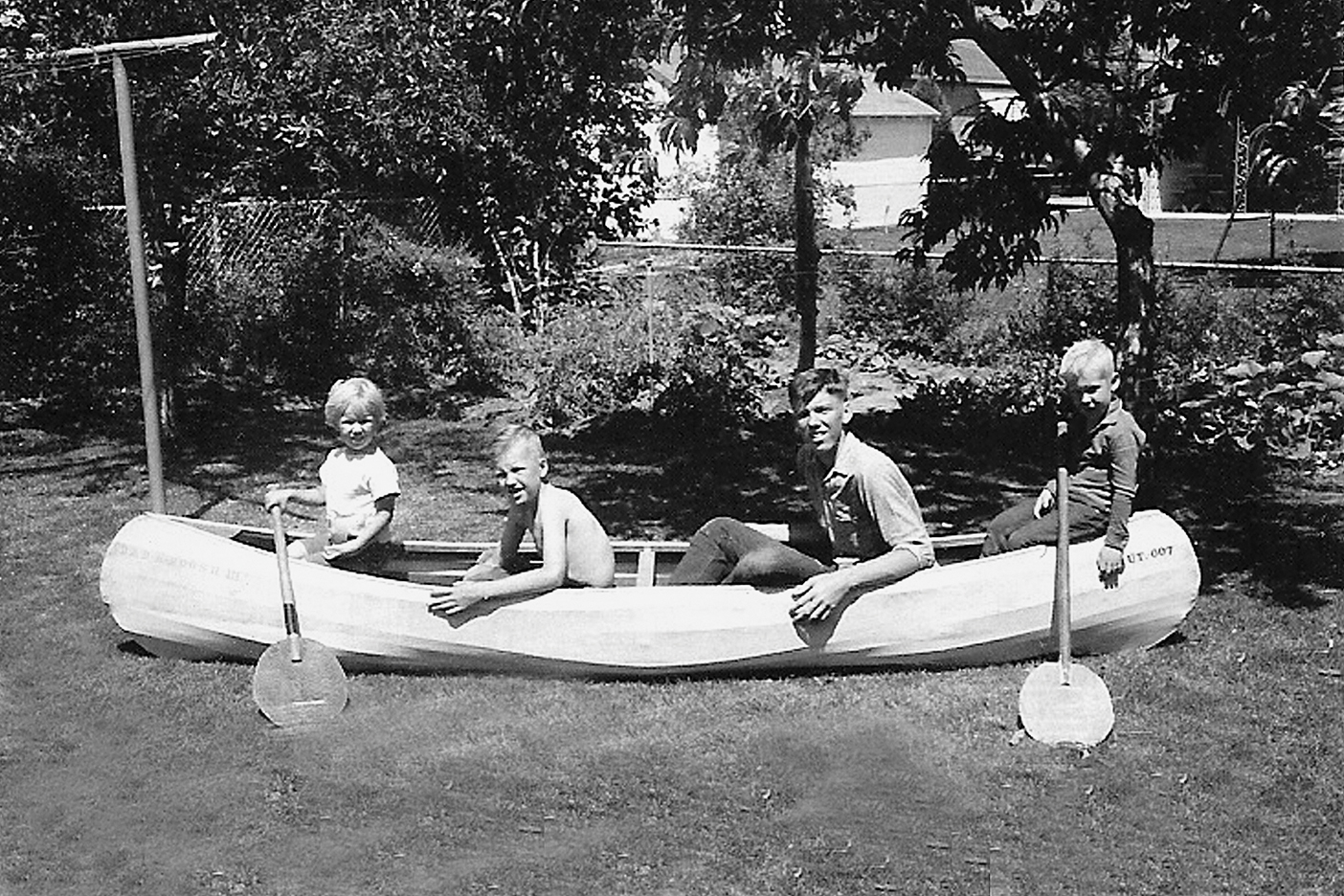
“He was very modest about his achievements,” says Stepan, who observed Clayton as his priests quorum advisor and then as bishop, “and yet he was achieving so much.”
When it came time to go to college, Clayton received acceptance letters from Harvard, Yale, and BYU. Leaning toward Harvard, he nevertheless decided to make the decision a matter of prayer. The clear impression to choose BYU instead was, says Clayton, his first distinct answer to prayer. Offered a scholarship to play basketball, he opted instead to accept the David O. McKay Scholarship, a full-ride academic award.
Entering BYU he says he felt like a kid in a candy store. During his first year he took everything from oriental mythology to economic geography to black history, eventually settling on an economics major. In Econ 111, taught by Larry T. Wimmer (BS ’60), Clayton was classmates with Kim B. Clark (’74)—later dean of the Harvard Business School and now BYU–Idaho president—and an ambitious kid named Mitt Romney (BA ’71). Both would become Christensen’s longtime neighbors, ward members, and friends in Belmont, Mass. Wimmer, who taught tens of thousands of students over 46 years, says that class and those promising three stand out clearly in his memory, and he followed their ensuing careers with interest. “Instead of giving them grades,” he quips, “I should have bought stock.”
But it was a student in Clayton’s 7 a.m. Book of Mormon class that first semester who made the strongest impression on him. Christine Quinn (BA ’74) seemed to have the attention of all the boys, and Christensen, when he later returned from a mission to Korea, says he found himself about 50th in her line of suitors. When he eventually proposed, he says, “she turned me down flat.” To show Christine he was going places, he applied for Oxford’s Rhodes Scholarship, not thinking he’d actually get it. And if somehow he did win the scholarship, he planned to turn it down so he could stay and pursue Christine. “That would be like giving eight cows for my wife,” he says.
Not only did he win the scholarship, but he also won the girl and ended up attending Oxford after all—though this meant postponing marriage a year due to a rule that required first-year Oxford students to live in the dorms.
At Oxford’s Queen’s College, where he studied applied econometrics, Clayton worked to cram the three-year program into just two while playing on the school’s national championship basketball team and serving as young men president in his struggling ward. But he says it was his daily labors from 11 p.m. until midnight that had the most lasting impact on his life.
“Why is success so hard to sustain, even by the best of the best?”
Realizing his testimony of the Book of Mormon was not adequate, he dedicated an hour each night to determining if what he’d been taught all his life was true or if truth was to be found elsewhere. Huddled by the heater in his room, he’d begin each session with verbal prayer, then read one page of the Book of Mormon, ponder its contents, and pray again, asking for a witness. He’d then turn the page and start the process again.
Weeks later, as he approached the end of 2 Nephi, he prayed and opened his scriptures to begin when “there came into that room a beautiful, warm, loving spirit that just surrounded me and permeated my soul and enveloped me in a feeling of love that I had not imagined that I could feel,” he recounted in a 2004 BYU–Idaho devotional. “I could see the glories of the eternity, and I could see what God had in store for me as one of His sons.”
“I use applied econometrics maybe once a year,” he continued, “but I use my knowledge that the Book of Mormon is the word of God many times every day of my life. In all of the education that I have pursued, that is the single most useful piece of knowledge that I ever gained.”
After graduating from Oxford, Christensen finally did make it to Harvard, where he added an MBA to his résumé before entering the business-consulting field and working for a time as an entrepreneur in Boston.
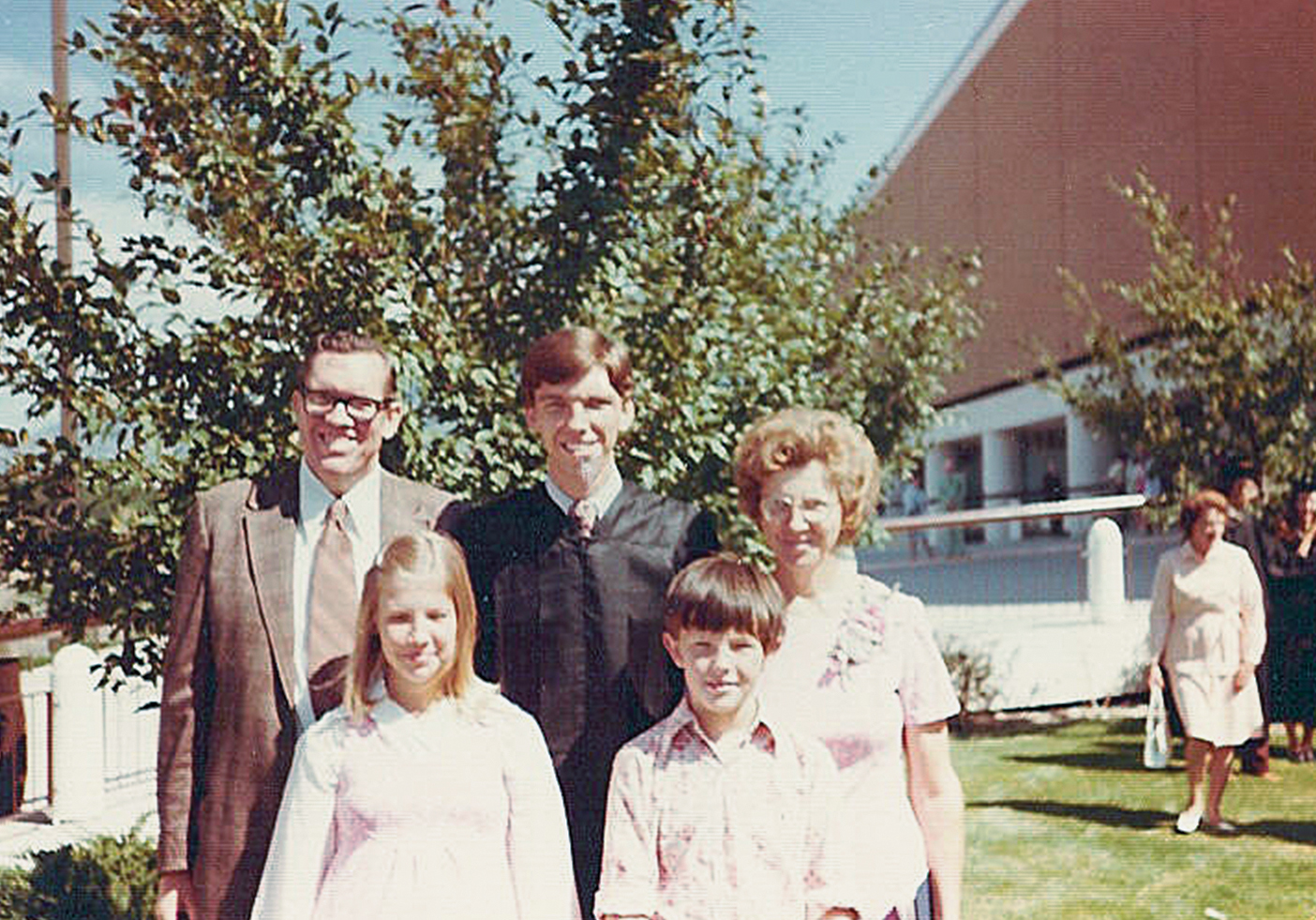
All along this path, observers say, Christensen remained an ordinary guy—just Clay.
If famous for anything during those years, it was for getting into work early enough each morning so that he could leave in time to play catch with his children while there was still daylight. A relentless worker, he’d momentarily set his briefcase aside to cheer for his five kids at swim meets and basketball games (“Be a leader, Spence!”) while scrawling their stats on a sheet to review with them later.
When his children were little, each night he’d tell them two stories—one from the scriptures or Church history or his mission, the other an impromptu tale starring themselves. It “always included the Christensen kids coming up with some ingenious solution to thwart Darth Vader’s latest plot to make the kids of our town unhappy,” remembers son Spencer Q. Christensen (BS ’12). “The implicit message was . . . ‘You guys are smart and have the ingenuity to solve the hardest and most important problems.’”
And he mined their thoughts on the problems he faced in his consulting work and later in his academic research. “He did it with such sincerity we honestly believed our input was valuable to his client companies,” says Spencer, who at 7 gave his dad some advice on how to address the concerns of a client named Bill Gates.
For family home evening, Christensen once tackled a fatherly frustration—persistent clean-towel shortages—with a lesson in Toyota’s kaizen production principles. Daughter Kate calls the kids “dinner-table MBAs” and says it’s no wonder that most have found their way into the world of business strategy and innovation.
But proud as they were of their dad, neither they, nor he, expected what was just around the corner. “He doesn’t seem to expect any of the . . . success that’s come to him,” says son Michael. He was just a regular, old-slacks-and-golf-shirt sort of guy.
When Right Is Wrong
Over the last two decades, Clayton Christensen has become perhaps the world’s leading expert in failure—and particularly in the failure of the big players of the business world. To put it more positively, he’s laid bare the mechanisms of how the little guys first carve out a toehold and eventually topple the kings of the mountain.
Although Christensen studies the epic fall of companies led by the most powerful CEOs, he doesn’t join in the refrain of disparaging these leaders as dummies or incompetents. In fact, it was the incongruity of it all—the smartest, most admired CEOs consistently leading their companies into nonexistence—that got him puzzling in the first place.
Why is success so hard to sustain, even by the best of the best?
When Christensen took the mid-life leap from his work as an entrepreneur back into academia at Harvard in the late ’80s, he tackled that question for his PhD dissertation. His specific focus was the disk-drive industry, but examples of the phenomenon popped up everywhere he turned—from retail giants like Sears to mainframe-computer companies to the auto industry to steel mills.
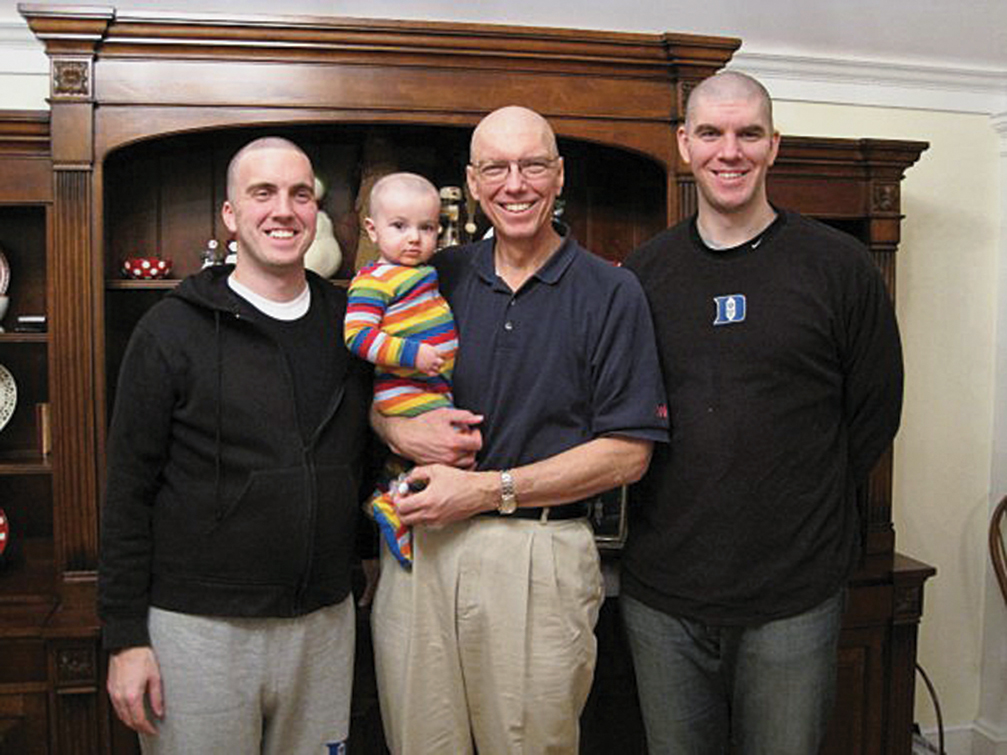
In each case, the managers of these companies at their apex followed the best practices they’d learned in business school—catering to their most loyal customers with products that yielded the highest returns. But inevitably, an inferior new product—usually lower tech, more cheaply made, and less profitable—would rise from the bottom of the market and give the industry a good shake, leaving the incumbents in disarray.
The aha moment—which would become the foundation for Christensen’s dissertation, his landmark best-seller The Innovator’s Dilemma, and his prominence in the field of innovation—came when he realized these companies were failing because of best practices. As these companies grew in size and their products became increasingly sophisticated, they lost both the appetite for and the nimbleness to respond to up-and-coming innovations at the bottom of the market. They became vulnerable to what Christensen coined as disruptive innovation.
Upon completion of his PhD, Christensen was hired onto the faculty of the Harvard Business School, receiving tenure in just six years—the quickest in the school’s modern history. Teaching the popular class Building and Sustaining a Successful Enterprise, he enlisted wave after wave of students to scrutinize his theory for holes. “Part of their assignment is to come to class to explain what Clay and his theories don’t explain,” says Christensen. “They [have] brought all kinds of examples that have . . . allowed us to improve the theory quite substantially.”
Further refinement has come as Christensen has sent his ideas out into the world, largely through Innosight, his consulting firm that has helped clients from Intel to the U.S. Department of Defense to Proctor & Gamble harness disruptive innovation in charting their future courses. A Christensen-led think tank, the Innosight Institute, applies the principles of disruptive innovation to societal conundrums, like soaring health-care costs and slumping education outcomes—both areas Christensen sees as being ripe for, and in dire need of, disruptive change. And his firm, Rose Park Advisors, invests in promising ventures with disruptive potential.
Christensen’s expertise, along with his difficulty saying no to requests, has made him a go-to guru for policymakers, a worldwide keynote speaker, and an expert for countless business-magazine stories. All of which has made his life very busy and kept him squarely, if uncomfortably, in the public eye. Younger brother Carlton says Clayton would be very happy without the regular write-ups in Forbes and BusinessWeek (and BYU Magazine, for that matter). “He worries . . . about these high-profile kinds of exposures,” he says. “He doesn’t really want it to be about him. He wants it to be about what he’s teaching.”
Carlton, a city council member representing Salt Lake’s Rose Park neighborhood for 15 years, laughs about a recent trip Clayton took to receive an honorary doctorate at a university in Taiwan. When Clayton got there, banners with his visage lined the streets, and Clayton brought one home as a memento. “The politician in me would have put it out on the front of my house,” says Carlton. “Clayton’s got his fixed to the inside of the door of the little shed that holds his lawnmower.”
Truth Is Truth Is Truth
Clayton Christensen remembers his fellow graduates of Harvard’s MBA program as smart, capable, and honorable—ready to conquer the world. But as each class reunion rolled around, he noted disturbing trends among his friends: more and more of them had experienced failed marriages, estranged relationships with their children, and disillusionment with their jobs. A few, he learned, had even spent time in jail. What had happened? he wondered. As a professor of business strategy, he surmised that the life strategies his friends had employed simply did not align well with their noble goals at graduation. Many had been wildly successful at making money, but that measure of success didn’t seem to correlate with personal and family happiness.
And so, for his last lecture of Building and Sustaining a Successful Enterprise each semester, Christensen turns the models his students have been studying back on the students: how can they build and sustain a successful life? And he uses his own life as a case study.
The lecture became so popular that students lobbied in 2010 to have Christensen give it as a graduation address. It was then published in the Harvard Business Review before being expanded into the 2012 best-seller How Will You Measure Your Life?
Part business-strategy manual, part self-help guide, and part memoir, the book (like its earlier iterations) erases the lines separating things academic, personal, and spiritual. Christensen, for instance, isn’t shy about noting his commitment not to play basketball on Sundays (even with a championship on the line) or how he came to know his life’s purpose while reading scriptures at midnight in his Oxford dormitory or his parental setbacks and victories. In encouraging his readers to develop a vision of who they can become, he happily shares his own, the personal statement that helped him regain his footing during his stroke rehabilitation: “A man dedicated to improving the lives of others; a kind, honest, forgiving, and selfless husband, father, and friend; and a man who doesn’t just believe in God, but who believes God.” How will his own life be measured? Not in positions held, keynotes delivered, or money earned, he tells them, but in individuals helped, one by one.
“What matters most is ‘Where can I do the most good?’” —Clayton Christensen
That blending of domains is more than just an approach to a book for Christensen—it’s a personal article of faith. He disagrees especially with the notion that the spiritual must be cordoned off from professional realms. He imagines a conversation with C.S. Lewis’ tempter Screwtape, who asserts that it simply isn’t politically correct to discuss faith at work. Christensen notes that when he’s not at work—at night and on the weekends—he’s typically with his family and other Church members: “So what you’re telling me is that for seven days a week, I can’t share the gospel with anybody, right?” To which Screwtape replies, “That’s the beauty of it.”
For one who wears his Mormonism on his sleeve (his homepage includes a link to his essay “Why I Belong and Why I Believe” right below his bio), Christensen receives remarkably little resistance from colleagues or clients. He believes it’s because he doesn’t present the gospel as a sales pitch, but rather as a collection of truths that relate both to matters of the soul and to the challenges of the company. “You just have to do it in an honest, open, everyday kind of way,” he says. “If I use principles of the gospel in an explicit way to solve the problems of my company or of the customers, there is no conflict whatsoever.”
And when the timing is appropriate, Christensen is fearless in making a low-pressure invitation for people to learn more.
Such invitations multiplied beginning in 1984, when Elder M. Russell Ballard taught members to set a date by which they would find someone for the missionaries to teach. Then a stake missionary, Christensen took the counsel to heart and has since set one to three such dates each year, in every case finding someone for the missionaries to teach in his home—often with just days to spare.
As he describes in the book The Power of Everyday Missionaries, released in January, Christensen has occasionally felt clearly directed to someone. But more often, his success has come simply because he has been willing to make hundreds of friendly invitations and let gospel truth shine everywhere.
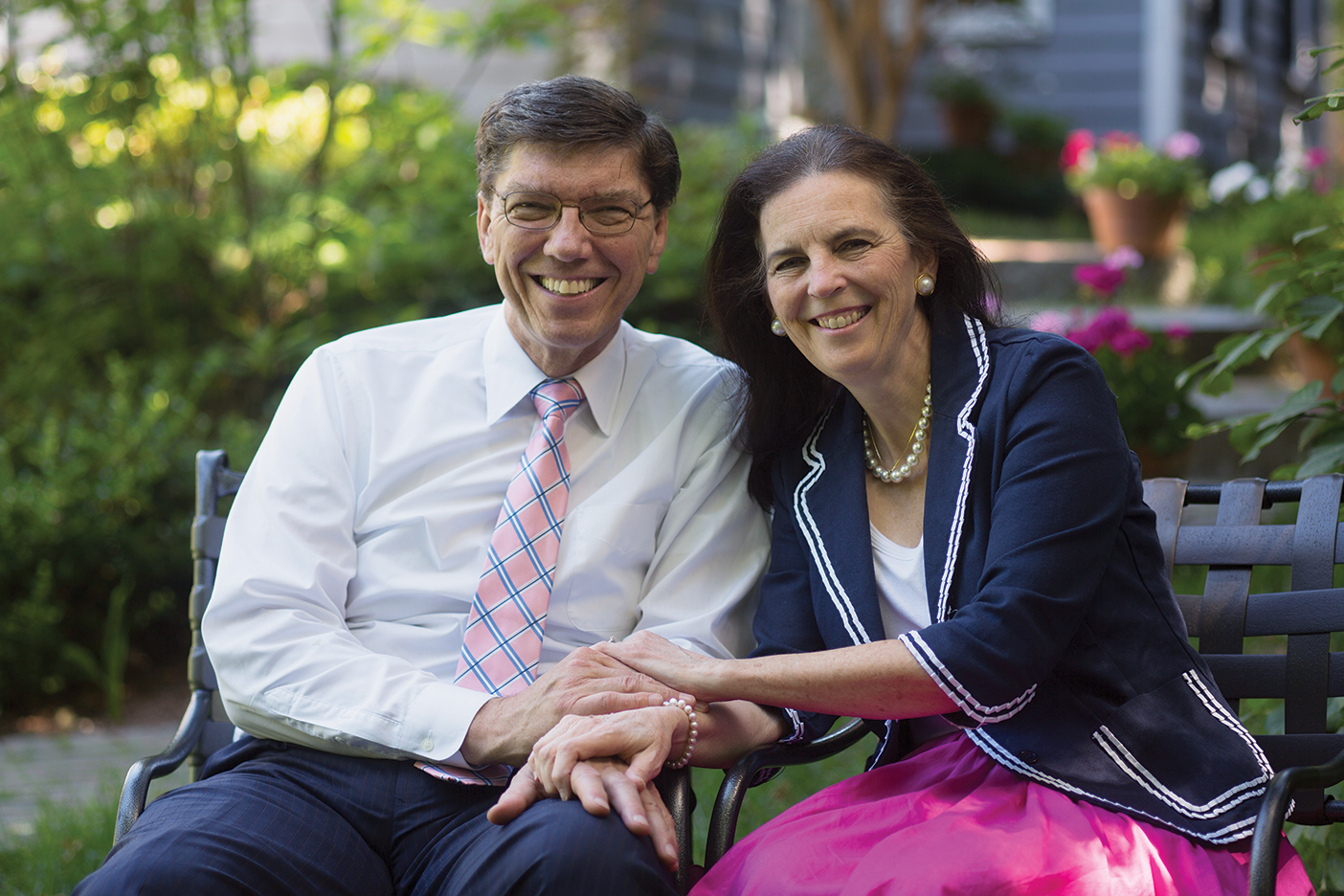
Good Work to Come
Lying in a guest bed in the home of a Montreal stake president, Clayton Christensen awoke at 3 a.m. to a terrible pain in his chest. Then serving as an Area Seventy, Clayton had driven with Christine to Montreal to preside over a 2008 stake conference. “We’d just had a wonderful set of meetings on Saturday,” he says, and he looked forward to more of the same on Sunday. So he made a quick calculation: “If I wake [Christine] up, she’s going to go wake up the stake president, . . . a physician, and they’re going to take me to the hospital, and that’s going to mess up this stake conference.”
Instead, he knelt beside the bed and prayed that, whatever it was, God would make it stop so Clayton could contribute to the stake conference. “And the pain stopped,” he says.
The next day, just after they arrived at home in Belmont, Christensen suffered a massive heart attack, the so-called widow maker. Christine rushed him to a nearby hospital, and the doctors saved his life. When he explained what had happened in Montreal, the doctor and Christine were stunned.
“If anything can happen to the poor guy, it does,” says Carlton of his brother’s procession of afflictions. “Job had a lot of problems, but Clayton is maybe second.”
Despite his early struggles with speech following his 2010 stroke, Christensen’s progress has been remarkable, though he still fumbles at times for the right word. He has returned to teaching, presenting, and writing, though what once was second nature is now exhausting work. “Before, if I had a good idea, I would just say it. I didn’t have to think about speech,” he says. “Now I have to continue to think about what I want to say, but also consciously and in parallel, I have to think about speaking.” By the end of the day, he says, it’s as though he’s run a mental 10K.

Although the slog of rehabilitation required Christensen to focus on himself, he found this to be a recipe for despair. Key to his happiness, he discovered anew, was shifting his attention elsewhere: “You’ve just got to find somebody who is in worse shape than you and help them be happy.”
Now finished with chemotherapy and in remission from his lymphoma, Christensen has emerged with some takeaways. Along with empathy for others who toil through pain and uncertainty, Christensen says his confrontations with mortality have given him a new perspective on death—and on life.
“There is no virtue in long life,” he says. “I never had framed it this way, but to ask for [God] to extend my life just to have a longer life just has no meaning.” With his certainty about what is to come, Christensen says it makes little difference which side of the veil he labors on. “What matters most is ‘Where can I do the most good?’”
Pursuing his deliberate and measured approach to life—afflictions notwithstanding—Christensen strides forward in his research, teaching, and publishing, determined to make the most of his remaining time. “For whatever reason, [God has] said I have more work to do here.”
Read more about Christensen’s conversion story on his website.
Hear Christensen explain disruptive innovation here.
Listen to Christensen’s thoughts on member missionary work from a 2009 fireside.
Feedback: Send comments on this article to magazine@byu.edu.


